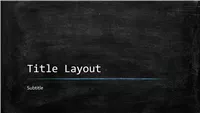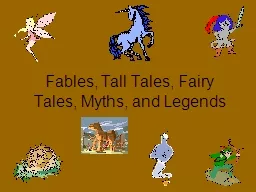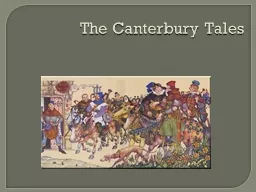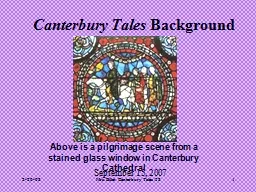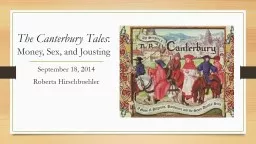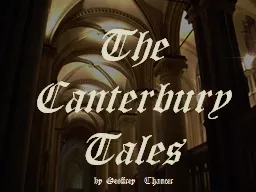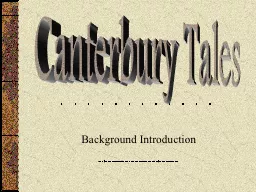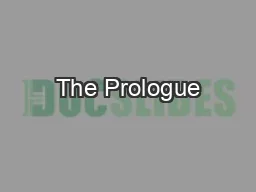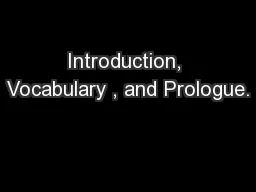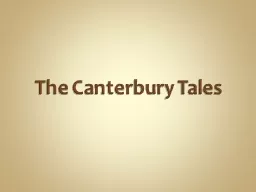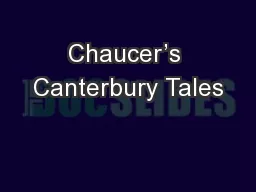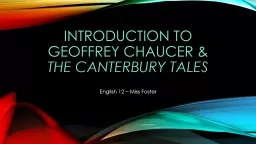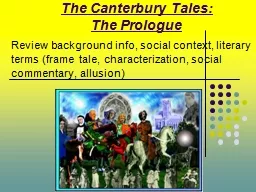PPT-The Canterbury Tales: Prologue
Author : briana-ranney | Published Date : 2017-12-29
Study Guide 1 st and 5 th Period Study Guide How does Chaucer use the pilgrimage in his story As a frame for the stories told by individual characters How is the
Presentation Embed Code
Download Presentation
Download Presentation The PPT/PDF document "The Canterbury Tales: Prologue" is the property of its rightful owner. Permission is granted to download and print the materials on this website for personal, non-commercial use only, and to display it on your personal computer provided you do not modify the materials and that you retain all copyright notices contained in the materials. By downloading content from our website, you accept the terms of this agreement.
The Canterbury Tales: Prologue: Transcript
Study Guide 1 st and 5 th Period Study Guide How does Chaucer use the pilgrimage in his story As a frame for the stories told by individual characters How is the narrator portrayed As stern and judgmental. Final Exam Review. Your test will cover…. The Canterbury Tales . Macbeth . MLA Format . Literary Terms. The Canterbury Tales. Chaucer (the author) . Social Structure of Medieval England . The General Prologue . Fables. Definition. : A brief story that sets forth some pointed statement of truth. Origin. : Found in almost every country. Handed down from generation to generation as oral literature. Content. : Usually contains incidents that relate to the unusual, sometimes supernatural. Introduction. The Canterbury Tales. was . written . in Middle English, over a period of years between 1386-1400 . written by Geoffrey Chaucer (c. 1340-1400) . written in the London dialect of Middle English . 1. Canterbury Tales. Background. September 15, 2007. Above is a pilgrimage scene from a stained glass window in Canterbury Cathedral. 2-20-08. Mrs. Billet Canterbury Tales /58. 2. Canterbury Tales. Background. :. Money, Sex, and Jousting. September 18, 2014. Roberta Hirschbuehler. Contents. Geoffrey Chaucer. Background on . The Canterbury Tales. More background. Middle English. The Narrator. The Knight. The . b. y Geoffrey Chaucer. The Canterbury Tales is about a group of 30 pilgrims travelling to visit the shrine of Thomas Becket in Canterbury. Each member of the group tells impressive stories, and the winner, chosen by the narrator, will receive a free meal on the way back.. Canterbury Tales. The Journey Begins . . .. Chaucer uses a religious pilgrimage to display all segments of medieval England.. The Canterbury Tales begins with a Prologue, . Narrator, presumably Chaucer himself, meets 29 other pilgrims at the Tabard Inn, located in a suburb of London.. The Canterbury Tales. Chaucer. Born in 1340’s. Son of well-to-do family of wine merchants in Ipswich. Work History:. Was a soldier, member of King’s household, a diplomat, custom house controller, justice of the peace, member of Parliament, forest official. Romeo and Juliet. What in the heck is a Chorus?. The term Chorus comes from ancient Greek drama.. An individual who guides the audience through the play and comments on the action of the drama. “I must . Characters: Page 785. The Prologue. Prologue. : A short introduction at the beginning of the play that . gives a brief . overview of the play. . Chorus. : A single actor who welcomes the audience and gives them . Written by Geoffrey Chaucer, who served in various court positions throughout his life. Follows the format of . The . Decameron. by . Boccacio. Incorporates characters from most social classes, mixing together . Brief Review. Organizational Plan. 4 tales per person: 2 coming; 2 going. Actually completed 22. Began 2 others. Journey to the shrine of Thomas a Becket in Canterbury. Becket, murdered in 1170. Use of journey motif as framing . Chaucer & . The Canterbury Tales. English 12 – Miss Foster. Geoffrey Chaucer. Born 1342, Died 1400 (both in London, England). Considered the “Father of English Literature”. Wrote in the common language of the people (Middle English). Review background info, social context, literary terms (frame tale, characterization, social commentary, allusion). Key Literary Devices. Frame Story. : . Narrative technique in which a main story is written to organize a set of shorter stories, each of which is a story within a story..
Download Document
Here is the link to download the presentation.
"The Canterbury Tales: Prologue"The content belongs to its owner. You may download and print it for personal use, without modification, and keep all copyright notices. By downloading, you agree to these terms.
Related Documents

